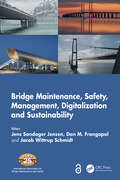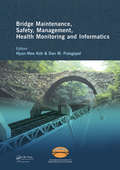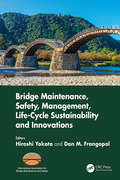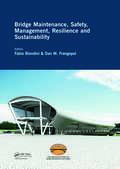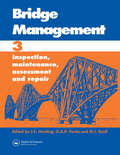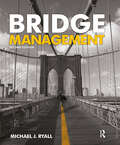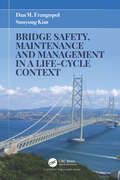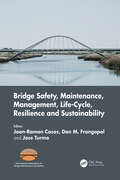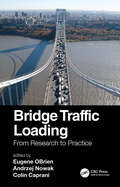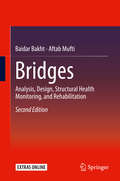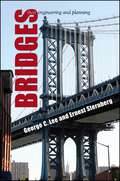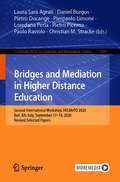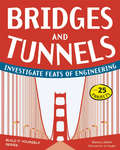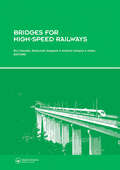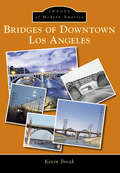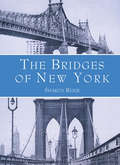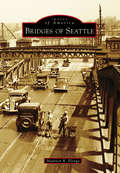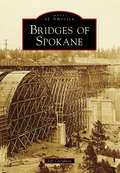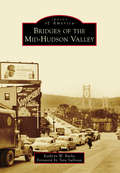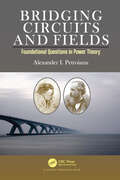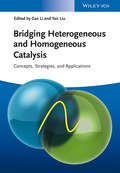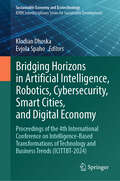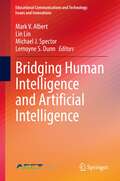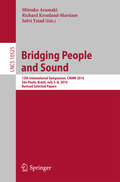- Table View
- List View
Bridge Maintenance, Safety, Management, Digitalization and Sustainability
by Jens Sandager JensenBridge Maintenance, Safety, Management, Digitalization and Sustainability collects the lectures and technical papers presented at the 12th International Conference on Bridge Maintenance, Safety and Management (IABMAS 2024, Copenhagen, Denmark, 24-28 June 2024). This Open Access book contains 480 contributions, including the T.Y. Lin Lecture, 9 Keynote Lectures, and 470 technical papers from 44 countries.The contributions are presented bring together academic and technological developments in Bridge Maintenance, Safety, Management, Digitalization and Sustainability, to solve new and old problems with innovative solutions. Major topics include: advanced bridge design, construction and maintenance approaches, safety, reliability and risk evaluation, life-cycle management, life-cycle resilience, sustainability, standardization, analytical models, bridge management systems, service life prediction, structural health monitoring, non-destructive testing and field testing, robustness and redundancy, durability enhancement, repair and rehabilitation, fatigue and corrosion, extreme loads, needs of bridge owners, whole life costing and investment for the future, financial planning and application of information and computer technology, extensive data analysis and artificial intelligence for bridges, among others.Bridge Maintenance, Safety, Management, Digitalization and Sustainability provides an up-to-date overview of the field of bridge engineering and significant contributions to making more rational decisions on bridge safety, maintenance, management, life-cycle, resilience, sustainability, and bridge innovations to enhance society’s welfare. The Editors hope that this book will serve as a valuable reference to all concerned with bridge structure and infrastructure systems, including engineers, researchers, academics, and students from all areas of bridge engineering.
Bridge Maintenance, Safety Management, Health Monitoring and Informatics - IABMAS '08: Proceedings of the Fourth International IABMAS Conference, Seoul, Korea, July 13-17 2008 (Bridge Maintenance, Safety and Management)
by Hyun-Moo Koh Dan M. FrangopolCollection of 550 revised, state-of-the art contributions on most recent advances in bridge maintenance, safety, management and life-cycle performance from leading experts in this area.
Bridge Maintenance, Safety, Management, Life-Cycle Sustainability and Innovations: Proceedings of the Tenth International Conference on Bridge Maintenance, Safety and Management (IABMAS 2020), June 28-July 2, 2020, Sapporo, Japan (Bridge Maintenance, Safety and Management)
by Hiroshi YokotaBridge Maintenance, Safety, Management, Life-Cycle Sustainability and Innovations contains lectures and papers presented at the Tenth International Conference on Bridge Maintenance, Safety and Management (IABMAS 2020), held in Sapporo, Hokkaido, Japan, April 11–15, 2021. This volume consists of a book of extended abstracts and a USB card containing the full papers of 571 contributions presented at IABMAS 2020, including the T.Y. Lin Lecture, 9 Keynote Lectures, and 561 technical papers from 40 countries. The contributions presented at IABMAS 2020 deal with the state of the art as well as emerging concepts and innovative applications related to the main aspects of maintenance, safety, management, life-cycle sustainability and technological innovations of bridges. Major topics include: advanced bridge design, construction and maintenance approaches, safety, reliability and risk evaluation, life-cycle management, life-cycle sustainability, standardization, analytical models, bridge management systems, service life prediction, maintenance and management strategies, structural health monitoring, non-destructive testing and field testing, safety, resilience, robustness and redundancy, durability enhancement, repair and rehabilitation, fatigue and corrosion, extreme loads, and application of information and computer technology and artificial intelligence for bridges, among others. This volume provides both an up-to-date overview of the field of bridge engineering and significant contributions to the process of making more rational decisions on maintenance, safety, management, life-cycle sustainability and technological innovations of bridges for the purpose of enhancing the welfare of society. The Editors hope that these Proceedings will serve as a valuable reference to all concerned with bridge structure and infrastructure systems, including engineers, researchers, academics and students from all areas of bridge engineering.
Bridge Maintenance, Safety, Management, Resilience and Sustainability: Proceedings of the Sixth International IABMAS Conference, Stresa, Lake Maggiore, Italy, 8-12 July 2012 (Bridge Maintenance, Safety and Management)
by Fabio Biondini Dan M. FrangopolBridge Maintenance, Safety, Management, Resilience and Sustainability contains the lectures and papers presented at The Sixth International Conference on Bridge Maintenance, Safety and Management (IABMAS 2012), held in Stresa, Lake Maggiore, Italy, 8-12 July, 2012. This volume consists of a book of extended abstracts (800 pp) Extensive collection of revised expert papers on recent advances in bridge maintenance, safety, management and life-cycle performance, representing a major contribution to the knowledge base of all areas of the field.
Bridge Management: Proceedings of the Third International Conference
by J. E. Harding G.E.R. Parke M. J. RyallThis volume contains the papers presented at the Third International Conference on Bridge Management, held at the University of Surrey, Guildford, UK on 14-17 April 1996.
Bridge Management, Second Edition
by M RyallAs the emphasis in construction moves from building new bridges to maintenance and rehabilitation of existing stock, bridge management is becoming an increasingly important subject. This is the definitive, single volume reference for professionals and postgraduates, covering the whole gamut of bridge management topics. Highly illustrated and in ful
Bridge Safety, Maintenance and Management in a Life-Cycle Context
by Dan M. Frangopol Sunyong KimDuring the past two decades, it has been generally acknowledged that life-cycle bridge analysis can be a systematic tool to address efficient and effective bridge management under uncertainty life-cycle management at the bridge network level can lead to an improvement in the allocation of limited financial resources, ensuring the safety and functionality of the bridge network life-cycle management of bridges and bridge networks based on resilience and sustainability can improve their resistance and robustness to extreme events such as earthquakes, tsunamis, floods, and hurricanes bridge management should consider the impact of environmental conditions and climate change This book addresses important concepts and approaches developed recently on bridge safety, maintenance, and management in a life-cycle context. Bridge life-cycle performance and cost analysis, prediction, optimization, and decision making under uncertainty are discussed. The major topics include bridge safety and service life prediction; bridge inspection and structural health monitoring; bridge maintenance; life-cycle bridge and bridge network management; optimum life-cycle bridge management planning; resilience and sustainability of bridges and bridge networksunder hazards; and bridge management considering climate change. By providing practical applications of the presented concepts and approaches, this book can help students, researchers, practitioners, infrastructure owners and managers, and transportation officials to build up their knowledge of life-cycle bridge performance and cost management at bothproject level and network level under various deteriorating mechanisms, hazards and climate change effects.
Bridge Safety, Maintenance, Management, Life-Cycle, Resilience and Sustainability: Proceedings of the Eleventh International Conference on Bridge Maintenance, Safety and Management (IABMAS 2022), Barcelona, Spain, July 11-15, 2022
by Joan-Ramon CasasBridge Safety, Maintenance, Management, Life-Cycle, Resilience and Sustainability contains lectures and papers presented at the Eleventh International Conference on Bridge Maintenance, Safety and Management (IABMAS 2022, Barcelona, Spain, 11–15 July, 2022). This e-book contains the full papers of 322 contributions presented at IABMAS 2022, including the T.Y. Lin Lecture, 4 Keynote Lectures, and 317 technical papers from 36 countries all around the world. The contributions deal with the state-of-the-art as well as emerging concepts and innovative applications related to the main aspects of safety, maintenance, management, life-cycle, resilience, sustainability and technological innovations of bridges. Major topics include: advanced bridge design, construction and maintenance approaches, safety, reliability and risk evaluation, life-cycle management, life-cycle, resilience, sustainability, standardization, analytical models, bridge management systems, service life prediction, structural health monitoring, non-destructive testing and field testing, robustness and redundancy, durability enhancement, repair and rehabilitation, fatigue and corrosion, extreme loads, needs of bridge owners, whole life costing and investment for the future, financial planning and application of information and computer technology, big data analysis and artificial intelligence for bridges, among others. This volume provides both an up-to-date overview of the field of bridge engineering and significant contributions to the process of making more rational decisions on bridge safety, maintenance, management, life-cycle, resilience and sustainability of bridges for the purpose of enhancing the welfare of society. The volume serves as a valuable reference to all concerned with and/or involved in bridge structure and infrastructure systems, including students, researchers and practitioners from all areas of bridge engineering.
Bridge to Freedom
by Isabel R. MarvinSynopsis: It is March 1945, the last days of World War II, just inside the German front. Kurt, a German army deserter, and Rachel, a 15-year-old Jew who has escaped from the terrors of Nazi Berlin, meet. The two must trust each other in order to survive and escape. For ages 10 and up.
Bridge Traffic Loading: From Research to Practice
by Eugene OBrien, Andrzej Nowak and Colin CapraniThere is considerable uncertainty about what level of traffic loading bridges should be designed for. Codes specify notional load models, generally to represent extreme levels of normal traffic, but these are often crude and have inconsistent levels of safety for different load effects. Over the past few decades, increasing quantities of reliable truck weight data has become available and it is now possible to calculate appropriate levels of bridge traffic loading, both for specific bridges and for a road network. Bridge Traffic Loading brings together experts from all over the world to deliver not just the state-of-the-art of vertical loading, but also to provide recommendations of best-practice for all the major challenges in the field – short-span, single and multi-lane bridge loading, dynamic allowance and long-span bridges. It reviews issues that continue to be debated, such as which statistical distribution is most appropriate, whether free-flowing or congested traffic governs and dealing with future traffic growth. Specialist consultants and bridge owners should find this invaluable, as will regulators.
Bridges: Analysis, Design, Structural Health Monitoring, and Rehabilitation
by Baidar Bakht Aftab MuftiThis book offers a valuable guide for practicing bridge engineers and graduate students in structural engineering; its main purpose is to present the latest concepts in bridge engineering in fairly easy-to-follow terms. The book provides details of easy-to-use computer programs for: · Analysing slab-on-girder bridges for live load distribution. · Analysing slab and other solid bridge components for live load distribution. · Analysing and designing concrete deck slab overhangs of girder bridges under vehicular loads. · Determining the failure loads of concrete deck slabs of girder bridges under concentrated wheel loads. In addition, the book includes extensive chapters dealing with the design of wood bridges and soil-steel bridges. Further, a unique chapter on structural health monitoring (SHM) will help bridge engineers determine the actual load carrying capacities of bridges, as opposed to their perceived analytical capacities. The chapter addressing structures made with fibre-reinforced polymers will allow engineers to design highly durable, economical and sustainable structures. This chapter also provides guidance on rehabilitating deteriorated structures with these new materials. The book also deals with the philosophy of bridge design without resorting to complex equations. Additional material to this book can be downloaded from http://extras. springer. com
Bridges: Their Engineering and Planning
by George C. Lee Ernest SternbergWhether you are a student considering a career in civil engineering and transportation planning, a public official interested in the future of infrastructure, or a person who simply cares about bridges, this book offers an accessible and illustrated introduction to the most beloved feature of our built environment. Learn about engineering basics: the forces that bridges must resist to stay aloft and the principles by which engineers decide which types of bridges make sense at which sites. Find out how engineers protect bridges from their greatest threats—the earthquakes, floods, and other hazards that can cause catastrophic damage.Moving from engineering to planning, learn how we decide whether a bridge is worth building in the first place, learn about controversial features of cost-benefit analysis, and about the transportation models by which planners forecast bridge effects on traffic patterns. Investigate a sometimes intractable problem: why a project often creeps along for a decade or more to get from initial studies to the day the ribbon is cut, undergoing vast cost escalations. Also explore the environmental impact of bridges, and the meaning of a "sustainable bridge," and whether bridges could once again be built, like ancient Roman ones, to last a thousand years.
Bridges and Mediation in Higher Distance Education: Second International Workshop, HELMeTO 2020, Bari, BA, Italy, September 17–18, 2020, Revised Selected Papers (Communications in Computer and Information Science #1344)
by Laura Sara Agrati Daniel Burgos Pietro Ducange Pierpaolo Limone Loredana Perla Pietro Picerno Paolo Raviolo Christian M. StrackeThis book constitutes the thoroughly refereed post-conference proceedings of the Second International Workshop on Higher Education Learning Methodologies and Technologies Online, HELMeTO 2020, held in Bari, Italy, September 2020. Due to the COVID-19 pandemic the conference was held online. The 25 revised full papers and 3 short papers presented were carefully reviewed and selected from a total of 59 submissions. The papers present recent research on challenges of implementing emerging technology solution for online, online learning pedagogical frameworks, facing COVID19 emergency in higher education teaching and learning, online learning technologies in practice, online learning strategies and resources, etc.
Bridges and Tunnels
by Jenn Vaughn Donna LathamBridges and tunnels are lifelines. People have tackled seemingly insurmountable obstacles, including vast canyons and mountain ranges, to design and construct these amazing passageways. Bridges and Tunnels: Investigate Feats of Engineering invites children ages 9 and up to explore the innovation and physical science behind structures our world depends on. Trivia and fun facts illustrate engineering ingenuity and achievements. Activities and projects encourage children to learn about the engineering process and to embrace trial and error.
Bridges for High-Speed Railways: Revised Papers from the Workshop, Porto, Portugal, 3 - 4 June 2004
by Rui Calçada Raimundo Delgado António Campos e MatosSince the 1980s in Europe high-speed rail has emerged rapidly as a means of transportation, and in the upcoming years many more tunnel, bridge and other infrastructure projects will be developed across the continent. At the same time design concepts and technologies have improved and innovative structural ideas have appeared, since trains travellin
Bridges of Downtown Los Angeles
by Kevin BreakThe Los Angeles River was tamed years ago. The river, by nature wanting to be violent and random, doses now in a concrete bed through downtown Los Angeles. In the city's core, there are over a dozen bridges that connect Los Angeles across the river--and these bridges are architectural marvels! These bridges were built in the first decades of the 1900s, and their history continues. The largest and longest bridge, the Sixth Street Viaduct, is in the process of being replaced. Others have been upgraded and enlarged; Spring Street is underway now. Many of the bridges were designed by one man, Merrill Butler, who made each bridge different, yet matching. In this volume, the reader will explore the necessity of the bridges, how they came to be, and where they are going in the future. The time is ripe for a reexamination of these jewels of downtown Los Angeles.
The Bridges of New York (New York City)
by Sharon ReierNew York City boasts more spectacular bridges than any other city in the world. From the Gothic stone arches and gossamer steel webbing of the Brooklyn Bridge (perhaps the greatest engineering achievement of the 19th century), to the Verrazano-Narrows — the world's longest suspension bridge when completed in 1964 — more than 75 bridges span the city's waterways. This book is a stirring text-and-picture tribute to these awe-inspiring structures.Beginning with Dutch New Amsterdam and continuing to the modern era and the achievements of legendary bridge builder Robert Moses, The Bridges of New York covers nearly 300 years of New York history and a century of accomplishments in modern engineering. At the time of construction, many of the bridges were considered breakthroughs in bridge-building technology.Grouped according to geography and economics — two prime considerations facing bridge engineers — the spans are described in a highly readable text that explains the design principles of cantilever, swing, bascule, and many other bridge types. Over 150 archival engravings and contemporary photographs document the splendor of such remarkable bridges as the Brooklyn, George Washington, Bronx-Whitestone, Manhattan, Queensboro, Triborough, and dozens of smaller spans.A section on bridge maintenance, a glossary, and charts noting each bridge's location, length, height, and other features complete this pictorial treasury — sure to delight engineering and architecture enthusiasts as well as anyone who has ever been astonished by the extraordinary scale and grandeur of New York's bridges.
Bridges of Seattle (Images of America)
by Maureen R. ElengaSeattle is situated in a region of outstanding scenic beauty, but the forested hills and numerous bodies of water that characterize the city were formidable obstacles to connecting its communities as it grew out from the historic center. Between 1896 and 1930, the city undertook massive landscape regrades, landfills, and waterway cuts to ease movement by land and water. The completion of these efforts allowed for the construction of Seattle's first permanent steel bridges beginning in 1910. Nine bridges included in this book are listed in the National Register of Historic Places. They include Washington's oldest steel arch bridge, the 1911 Twelfth Avenue South Bridge; the 1913 Ravenna Park Bridge; all four of the Lake Washington Ship Canal bascules, constructed between 1917 and 1924; and the Depression-era Aurora, Cowen Park, and Schmitz Park bridges. Bridges of Seattle explores the history of the spans that are a quintessential part of the Seattle experience.
Bridges of Spokane
by Jeff CreightonSpokane's history begins with the arrival of explorer David Thompson, who established the trading post Spokane House in 1810. From that period forward, the area teemed with Euro-American settlers who often mingled with the Native American population. Spokan Falls, officially incorporated in 1881, and by 1891 known simply as Spokane, became ground zero for the extractive industries of mining and logging and later a vast hub for the railroads. These factors led to the greatest boom in the city's history between the years 1900 and 1915. Spokane's growth came on the heels of an increase in the built environment that included the creation of parks, subdivisions, an expanded downtown business district, and an almost feverish movement to create some of Washington's most beautifully designed bridges. Because of this, Spokane has often been referred to as the "City of Bridges."
Bridges of the Mid-Hudson Valley (Images of America)
by Kathryn W. BurkeThe Hudson River bridges, iconic structures of the New York State Bridge Authority, are the cornerstone of the Mid-Hudson Valley. Opened in 1924, the Bear Mountain Bridge was the first vehicular crossing of the Hudson River, south of Albany. Twentieth-century growth in the Hudson Valley can be traced to each bridge opening, the result of grassroot efforts by local residents. The Mid-Hudson Bridge, named for the region these bridges span, was designated an "Engineering Epic" following the tipping of the east caisson that delayed construction for a year while engineers and laborers struggled to right that caisson in the waters of the Hudson River. The plan for the Rip Van Winkle Bridge required the creation of the New York State Bridge Authority, when funding was otherwise impossible during the Great Depression. Three more bridges were built connecting remaining areas of the Mid-Hudson region. The last crossing became the "twin spans" of the Newburgh-Beacon Bridge, the New York State Bridge Authority's most traveled span. In 2010, the New York State Bridge Authority gained ownership of the bridge structure of the Walkway Over the Hudson, a pedestrian walkway built on the old Poughkeepsie Bridge, which opened for trains in 1889.
Bridging Circuits and Fields: Foundational Questions in Power Theory
by Alexander I. PetroianuEnergy and power are fundamental concepts in electromagnetism and circuit theory, as well as in optics, signal processing, power engineering, electrical machines, and power electronics. However, in crossing the disciplinary borders, we encounter understanding difficulties due to (1) the many possible mathematical representations of the same physical objects, and (2) the many possible physical interpretations of the same mathematical entities. The monograph proposes a quantum and a relativistic approach to electromagnetic power theory that is based on recent advances in physics and mathematics. The book takes a fresh look at old debates related to the significance of the Poynting theorem and the interpretation of reactive power. Reformulated in the mathematical language of geometric algebra, the new expression of electromagnetic power reflects the laws of conservation of energy-momentum in fields and circuits. The monograph offers a mathematically consistent and a physically coherent interpretation of the power concept and of the mechanism of power transmission at the subatomic (mesoscopic) level. The monograph proves (paraphrasing Heaviside) that there is no finality in the development of a vibrant discipline: power theory.
Bridging Heterogeneous and Homogeneous Catalysis
by Yan Liu Can LiThere are two main disciplines in catalysis research -- homogeneous and heterogeneous catalysis. This is due to the fact that the catalyst is either in the same phase (homogeneous catalysis) as the reaction being catalyzed or in a different phase (heterogeneous catalysis). Over the past decade, various approaches have been implemented to combine the advantages of homogeneous catalysis (efficiency, selectivity) with those of heterogeneous catalysis (stability, recovery) by the heterogenization of homogeneous catalysts or by carrying out homogeneous reactions under heterogeneous conditions. This unique handbook fills the gap in the market for an up-to-date work that links both homogeneous catalysis applied to organic reactions and catalytic reactions on surfaces of heterogeneous catalysts. As such, it highlights structural analogies and shows mechanistic parallels between the two, while additionally presenting kinetic analysis methods and models that either work for both homogeneous and heterogeneous catalysis. Chapters cover asymmetric, emulsion, phase-transfer, supported homogeneous, and organocatalysis, as well as in nanoreactors and for specific applications, catalytic reactions in ionic liquids, fluorous and supercritical solvents and in water. Finally, the text includes computational methods for investigating structure-reactivity relations. With its wealth of information, this invaluable reference provides academic and industrial chemists with novel concepts for innovative catalysis research.
Bridging Horizons in Artificial Intelligence, Robotics, Cybersecurity, Smart Cities, and Digital Economy: Proceedings of the 4th International Conference on Intelligence-Based Transformations of Technology and Business Trends (ICITTBT-2024) (Sustainable Economy and Ecotechnology)
by Klodian Dhoska Evjola SpahoThis book aims to foster interdisciplinary research among industry and academic participants and form long-term strategic links. It provides a presentation of new knowledge and development through the exchange of practical experience between industry, scientific institutes and business. The carefully selected conference themes have been chosen to engender these in the fields of engineering, industry, information technology, business, economics and finance, and applied sciences. This book aims to provide the latest research findings, innovative research results, methods and development techniques from both theoretical and practical perspectives related to the emerging areas of artificial intelligence, cybersecurity, robotics and automation, smart technologies, data analytics and data science, network and communication, cloud and mobile computing, Internet of things, virtual augmented and mixed reality, technology in applied science, digital economy, management and business, finance and accounting, statistics and econometrics, economics and social sciences.
Bridging Human Intelligence and Artificial Intelligence (Educational Communications and Technology: Issues and Innovations)
by Lin Lin Michael J. Spector Mark V. Albert Lemoyne S. DunnThis edited volume is based on contributions from the TCET-AECT “Human-Technology Frontier: Understanding the Learning of Now to Prepare for the Work of the Future Symposium” held in Denton, Texas on May 16-18, sponsored by AECT. The authors embrace an integrative approach to designing and implementing advances technologies in learning and instruction, and focus on the emerging themes of artificial intelligence, human-computer interactions, and the resulting instructional design. The volume will be divided into four parts: (1) Trends and future in learning and learning technologies expected in the next 10 years; (2) Technologies likely to have a significant impact on learning in the next 10 years; (3) Challenges that will need to be addressed and resolved in order to achieve significant and sustained improvement in learning; and (4) Reflections and insights from the Symposium that should be pursued and that can form the basis for productive research collaborations. The primary audience for this volume is academics and researchers in disciplines such as artificial intelligence, cognitive science, computer science, educational psychology, instructional design, human-computer interactions, information science, library science, and technology integration.
Bridging People and Sound: 12th International Symposium, CMMR 2016, São Paulo, Brazil, July 5–8, 2016, Revised Selected Papers (Lecture Notes in Computer Science #10525)
by Mitsuko Aramaki Richard Kronland-Martinet Sølvi YstadThis book constitutes the thoroughly refereed post-conference of the 12th International Symposium on Computer Music Modeling and Retrieval, CMMR 2016, held in S#65533;o Paulo, Brazil, in July 2016. The 22 full papers presented were carefully reviewed and selected from 40 submissions. This year's conference theme "Bridging People and Sound" aimed at encouraging contributions from artists and listeners on the one side and audio and music technology researchers on the other.
